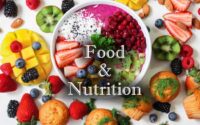Food and Nutrition MCQ
In this Article, we have provided the Food and Nutrition MCQ Question Papers along with Solutions. So, the interested candidates who applied for jobs in Food and Nutrition can download Food and Nutrition MCQs Question Papers for free of cost. Get all the Food and Nutrition MCQ Question Papers with just one click.

Click on the enclosed links below to download the Food and Nutrition MCQ Question Papers. Check the Last five years Food and Nutrition MCQ Question Papers to get a clear idea of the exam pattern. Along with Food and Nutrition MCQs Question Papers, it’s better to refer Food and Nutrition Syllabus & Exam Pattern before starting preparation. So, click on link to check and download Food and Nutrition MCQ Question Papers PDF.
MCQ Question Papers on Food and Nutrition
1. In pre-cooling, water is mostly removed by:
a. Convection
b. Conduction
c. Radiation
d. None of these
2. Albinism is an important physiological disorder of:
a. Plum
b. Peach
c. Strawberry
d. Cherry
3. Calliper grade is the maturity measurement for :
a. Apple
b. Mango
c. Banana
d. Pineapple
4. Formation of abscission layer is maturity index of :
a. Tomato
b. Leafy vegetables
c. Melons
d. Onion
5. What is the maturity index for Avocado?
a. Sugar content
b. Acid content
c. TSS
d. Oil content
6. Which of the following is biodegredable plastic?
a. Poly propylene
b. LDPE
c. Polythene
d. Polyhydroxy butyrate
7. As fruits mature, the specific gravity will:
a. Increase
b. Decrease
c. Remains constant
d. None of these
8. ‘Solidity’ is the maturity index for:
a. Root vegetables
b. Seed vegetables
c. Leafy vegetables
d. Cucurbits
9. Which of the following plant hormone is considered as ripen?
a. Cytokinin
b. GA3
c. Ethylene
d. IAA
10. Maximum density of water is at a temperature of :
a. 0°C
b. 4°C
c. 4°C
d. -7°C
11. Guava fruit is botanically known as:
a. Drupe
b. Sorosis
c. Berry
d. Pome
12. In onion pink colour is due to:
a. Anthocyanin
b. Carotene
c. Xanthophyll
d. Quercitin
13. Secondary metabolites:
a. are essential to microbe function
b. are by-products of metabolism that are not important to microbe function
c. are products that require additional processing before they can be packaged
d. are harvested during the exponential phase of growth
14. Hen and Chicken disorder is associated with:
a. Mango
b. Tomato
c. Grapes
d. Guava
15. The membrane lipid hypothesis was given by:
a. Kidd & West
b. James Harrison
c. Raison & Lyons
d. Graham & Patterson
16. The point at which the dried products just become lumpy is known as?
a. Danger Point
b. Saturated Point
c. Critical Point
d. Safety Point
17. What is the percentage of sugars in Honey?
a. 42%
b. 82%
c. 65%
d. 62%
18. Fungus which mostly grown on grapes:
a. Geotrichum
b. Penicillium
c. Botrytis
d. Colletotrichum
19. Vitamin D is chemically known as:
a. Retinol
b. Cobalamin
c. Calciferol
d. Tocopherol
20. Lye peeling is done at a temperature of:
a. 75°C
b. 84°C
c. 93°C
d. 105°C
| Practice Papers | Quiz |
| Easy Question | Previous Question |
| Difficult Question | Sample Papers |
| Important Question | Model Papers |
| GK | Food Safety |
| MCQs |
21. Which of the following is associated with ‘browning’ disorder?
a. Apple
b. Cabbage
c. Cauliflower
d. Citrus
22. What is the threshold level of ethylene in fruit and vegetable?
a. 0.01 μL/L
b. 0.02 μL/L
c. 0.03 μL/L
d. 0.04 μL/L
23. Which of the following is a rapid precooling method?
a. Forced air Cooling
b. Hydro Cooling
c. Vacuum Cooling
d. Evaporative Cooling
24. In cucumber, chilling- injury symptoms occur at:
a. <7°C
b. 7°C
c. 10°C
d. >10°C
25. Degreening is not applicable in:
a. Banana
b. Guava
c. Mango
d. Citrus
26. Under normal conditions Orchid can be stored upto 2 weeks at:
a. 2-4°C
b. 5-7°C
c. 7.5- 10°C
d. >10°C
27. What is the operating principle behind oven drying for determining moisture content of foods?
a. Colour change is measured
b. Loss of weight represents loss of water
c. Change in refractive index is measured
d. Change in light absorbance is measured
28. Which of the following packages is an example of aseptic packaging?
a. Tetra Pak drinking boxes
b. Paper bag
c. Milk carton
d. Plastic bread bag
29. Which of the following ingredients in chocolate milk comes from seaweed?
a. Carrageenan
b. Cocoa
c. Sucrose
d. Glucose
30. Which microorganism is commonly associated with fecal contamination?
a. Clostridium botulinum
b. Campylobacter jejuni
c. Bacillus cereus
d. Trichinella spiralis
31. Which of the following analytical methods can be used to distinguish flavour compounds?
a. Hydrometry
b. Near infrared spectroscopy
c. Polarimetry
d. Gas chromatography
32. Which of the following microorganisms cannot tolerate oxygen?
a. Clostridium botulinum
b. Staphylococcus aureus
c. Penicillium roquefortii
d. E. coli
33. Which of the following methods is a quick test for sugar content during the early stages of the brewing process for beer?
a. Hydrometry
b. Babcock test
c. Wet ashing
d. Soxhlet extraction
34. Which of the following processing methods involves heating foods at high temperatures for short periods of time in order to reduce the risk of food poisoning?
a. Blanching
b. Ohmic heating
c. Irradiation
d. Pasteurization
35. Which of the following does not have antimicrobial activity?
a. Chlorophyll
b. Organic acids
c. Spice extracts
d. Hydrogen peroxide
36. What is the percent of acetic acid in commercially available vinegar?
a. 2%
b. 4%
c. 6%
d. 10%
37. Which of the following is not an intrinsic factor in food spoilage?
a. pH
b. Moisture
c. Temperature
d. available nutrients
38. Lyophilization is synonymous with:
a. Freeze-drying
b. Pasteurization
c. Filtration
d. Spoilage
39. Antibiotics tend to be:
a. Primary metabolites
b. Secondary metabolites
c. Tertiary metabolites
d. Quaternary metabolites
40. Amino acids are used as food additives for which of the following reasons?
a. As natural antibiotics
b. As natural growth inhibitors
c. For nutritive purposes
d. As antioxidants
41. Grinding and mixing of foods such as sausage and hamburger:
a. Increase the food surface area
b. Alter cellular structure
c. Distribute contaminating microorganisms throughout the food
d. All of the above
42. Louis Pasteur established the modern era of food microbiology in 1857 when he showed that microorganisms cause ______ spoilage:
a. Beer
b. Wine
c. Juice
d. Milk
43. Despite efforts to eliminate spoilage organisms during canning, sometimes canned foods are spoiled. This may be due to:
a. Spoilage before canning
b. Underprocessing during canning
c. Leakage of contaminated water through can seams during cooling
d. All of the above.
44. The effectiveness of many chemical preservatives depends primarily on the food:
a. Temperature
b. pH.
c. Water content
d. Acidity.
45. Which type of fermentation is used to produce yogurt?
a. Mesophilic
b. Thermophilic
c. Therapeutic
d. Yeast-lactic fermentations
46. Which of the following refers to the addition of microorganisms to the diet in order to provide health benefits beyond basic nutritive value?
a. Antibiotics
b. Prebiotics
c. Probiotics
d. All the above
47. Moisture content in intermediate moisture food (IMF) is:
a. 10-20%
b. 20-25%
c. 20-40%
d. 15-50%
48. Deep frying of potato chips lead to generation of carcinogen:
a. Acrylamide
b. Acefamide
c. Formamide
d. Antioxidants
49. Which of the amino acid is not essential in diet:
a. Tyrosine
b. Tryptophan
c. Phenyl alanine
d. Lysine
50. Material suitable for micro-wave heating:
a. EPP
b. LDPE
c. PET
d. DAIP

